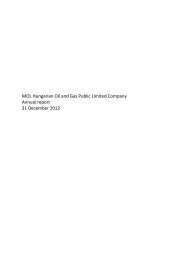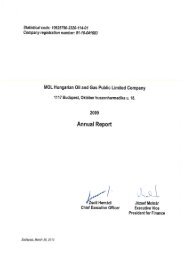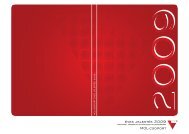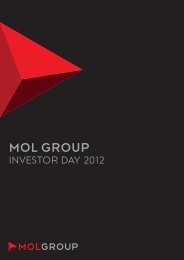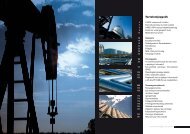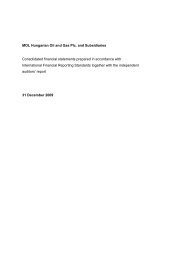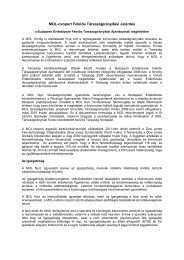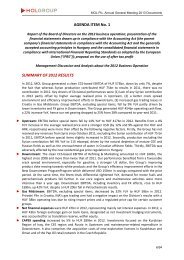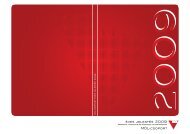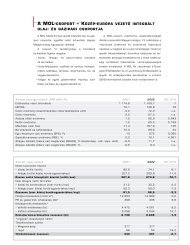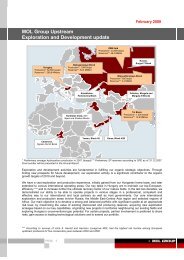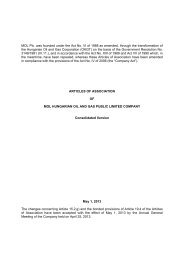MOL GROUP Annual Report
MOL GROUP Annual Report
MOL GROUP Annual Report
- No tags were found...
You also want an ePaper? Increase the reach of your titles
YUMPU automatically turns print PDFs into web optimized ePapers that Google loves.
Moderating growth in world economy,downside risks mainly in the EurozoneSignificant oil price increaseRefining margins: Slowly improvingcrack spreadsSignificant volatility of local currenciesTransition year in external environmentThe global economy went through a transition period from a strong bounce-backphase seen in the first half of 2010 to a less rapid but apparently more sustainablegrowth path in the second half of the year. The main driving force behind theoverall recovery was the continuing strong performance of the leading emergingeconomies. At the same time, the recovery of advanced economies remainedslower, although the US and Japan performed significantly better than previouslyexpected due to additional stimulus measures. The main source of weaknesseswithin the advanced economies group was the troubled periphery of the Eurozone.The Greek debt crisis in Q2 caused severe market turbulence and prompted the EUto set up an unprecedented EUR 440 bn bailout fund to contain the fallout fromfuture crises, which prevented a more widespread spillover from the periphery tothe core of the Eurozone in case of the Irish bailout later in Q4. Nevertheless, therisk of future liquidity crises and bailouts within the Eurozone remains high, and asa result volatility in exchange rate movements is expected to continue.Overall, the IMF estimates that global economic growth will somewhat moderatefrom 5.0% in 2010 to 4.4% in 2011 due to the necessary fiscal consolidation inmost advanced economies.Oil prices strengthened significantly during 2010 and averaged at 79.5 USD/bbl,nearly 29% higher than a year ago. The price increase was more or less gradualwith only two significant corrections seen in May and August. The first temporarydrop was caused by the market reaction following the Eurozone debt crisis, andthe second by more general concerns about the outlook for global growth inlight of an apparent slowdown in China. Nevertheless, the overall growing trendwas fully supported by the annual 2.7 MMboepd increase in the demand in 2010,which is one of the strongest annual growth in decades. Other fundamentalsalso increased throughout 2010. OPEC’s effective spare capacity slowly erodedto below 5 mn bbl/day by Q4 2010. The fact that the growing trend in oil pricescontinued in spite of the diminishing quota compliance of OPEC, which droppedto around 58% by December from around 63% a year ago suggests the slow returnto a tighter oil market similar to the one seen in the pre-crisis years.Refining margins remained below the 5-year average in 2010. The healthy rateof recovery pushed up product demand in emerging economies and to a lesserextent in OECD countries in Europe and North America as well, which resulted instronger product crack spreads across the board in 2010 than in the previous year.Nevertheless, persistently high inventory levels as well as ample spare refiningcapacities combined with the slow pace of closing uncompetitive refinerieslimited the strengthening of crack spreads. Naphtha and gasoline crack spreadsexceeded their 5-year averages, but followed a mildly declining trend, while dieseland jet fuel crack spreads remained below their historical averages, but followeda slowly strengthening trend throughout the year. The historically negative fueloil crack spread remained stronger than the 5-year average, but it started to inchcontinuously towards pre-crisis lows from the second half of the year. The Brent-Urals spread recovered somewhat to around 1.4 USD/bbl in 2010 from below 1 USD/bbl in 2009, but followed a relatively volatile pattern throughout the year.Hungarian Forint (HUF) and Croatian Kuna (HRK) weakened just slightly againstUSD in 2010, but the exchange rates were charachterised with high volatilityduring the year. The HUF weakened by about 3% against the US Dollar in 2010:the average exchange rate in 2010 was 208.1 HUF/USD and 202.3 HUF/USD in2009. The HUF strengthened by 2% against the EUR in 2010 (275.4 HUF/EUR in2010 vs. 280.6 HUF/EUR in 2009). The Croatian Kuna weakened slightly by about4% against the USD in 2010 (5.5 HRK/USD in 2010 vs. 5.3 HRK/USD in 2009).CEE economy: Two-speed recoverycontinuedUnfavorable changes in HungariantaxationGas transmission: changes inregulated gas transmission tariffsUpstream: regulated gas pricesintroduced for eligible customers inHungaryThe CEE region’s recovery progressed at two-speeds during most of 2010 withPoland, Slovakia and the Czech Republic performing strongly, while Hungary,Croatia and Romania, among others, continued to lag behind. The recovery inmost countries of the region is still mostly driven by the manufacturing boom inGermany rather than by domestic demand, which is depressed by stubbornly-highunemployment rates and continuously weak credit growth. The motor fuel demanddrop across the CEE region remained modest in 2010 with gasoline decreasing bya notable 4.9% but diesel growing by 1.9% resulting in and overall fuel demanddrop of only 0.1%. Economic growth will face headwinds as most countries in theregion will carry out some degree of fiscal consolidation throughout 2011.Changes in the regulatory environmentAlthough there were several changes in the tax laws of Hungary in 2010, theintroduction of an extra tax on energy suppliers (crisis tax) for the years between2010 and 2012 had the most significant impact on <strong>MOL</strong> Group. As for 2010 theGroup level liability amounted to HUF 25.8 bn. The tax regulatory environmentin Hungary was less stable as certain changes approved during 2010 becameeffective backwards from 1 January 2010 (e.g. introduction of crisis tax).Another important but in terms of effect on <strong>MOL</strong> Group less significant change wasthe increase of corporate income tax rate to 19% from 16% and the abolishmentof the companies’ 4% solidarity surplus tax as of 1 January 2010.Although the Robin Hood tax was planned to be abolished by the end of 2010,it remains effective till the end of 2012, based on the latest changes of the lawapproved in Q4 2010.The rate of return on regulated asset base (RAB) for domestic regulatedtransmission activity was 8.78 % between 1 January 2010 and 3 December 2010.However from 4 December 2010 a dual tariff system was introduced in which thetransmission tariffs were calculated at 4.5% Return on RAB for the consumergroup entitled to universal service while 8.78% Return on RAB remained for theother consumers. This modification reduced the profit by about HUF 250 mn forthe 2010 ecenomic year.The regulatory authority did not comply with its statutory duty by 1 July 2010,the tariff maintenance mechanism defined by laws was not carried out, thesystem usage fees were frozen by the Price Authority. Thus the tariff correctionon capacity booking, gas price growth and depreciation did not happen for thenew gas year.This caused about HUF 10 bn loss in revenues for 2010 which could not be fullycompensated by the austerity measures.Therefore in 2010 the income on domestic transmission of FGSZ did not reach therevenues previously determined by the laws.In 2011 the average yield of natural gas system is expected to be around 6.5%taking into account the rates used to calculate the transmission charges publishedby the Hungarian Energy Office.The regulated income of FGSZ will be expectedly under the revenues determinedby the new rules due to the impact of frozen tariffs gone into the first half of 2011.Starting from December 2010 regulated gas price system for eligible customerswas introduced in Hungary. The regulated price and volume are announced inadvance quarterly by National Development Ministry. The regulated price is validonly for gas produced from fields put into production before 1998. The regulationis expected to be ceased in 2013.Management Discussionand Analysis54 <strong>MOL</strong> Group ANnual <strong>Report</strong> 2010 55



